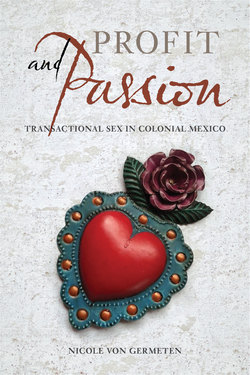Profit and Passion

Реклама. ООО «ЛитРес», ИНН: 7719571260.
Оглавление
Nicole von Germeten. Profit and Passion
Отрывок из книги
Profit and Passion
Nicole von Germeten
.....
Crown regulation picked up from the 1560s to the 1580s, foreshadowing suppression in the seventeenth century (chapter 2). Phillip II imposed new and more serious penalties on ruffians in a 1566 decree, an extension of his father’s policies noted above. The king also commanded that husbands who consented to their wives’ “doing evil with their bodies” for money should receive the same harsh punishments as did any other ruffian: public shaming on the first offense, along with ten years of rowing in the galleys, and one hundred lashes (individual strokes with a whip of a varying degree of intensity) and a perpetual sentence of galley slavery for the second offense. One surviving document indicates that the sentence of galley slavery might actually bring ruffians to the Caribbean, where they possibly could restart their occupation in a new locale.69 The crown also began issuing a long series of recurring decrees against “pecados publicos” (public sins including adultery, concubinage, and pandering) in this era. For example, a 1570 royal cedula promulgated by the viceroy of Peru demanded that the viceroy of New Spain and the high courts of all Spanish American territories punish public sins as a gesture of mourning for the death of Phillip II’s wife, Ana of Austria.70 A similar decree came out of Madrid in 1583, due to the death of the infante Diego, heir to the throne.71 Spanish monarchs repetitively propagated these decrees into the next century.72
In the oldest case, dating from 1555, Francisco Saavedra, an alguacil for the archbishop of Mexico City, accused a forty-year-old indigenous women, addressed as both Ana and María Tepe, of making money as an “alcahueta” for “Indians, Spaniards, Blacks, and mestizos.”74 The accused denied all of the accusations, claiming that she made her income by selling her tortillas. The eight male Spanish witnesses for the prosecution backed up Saavedra, although their statements refined the racial parameters of Tepe’s business model. In a canny exploitation of postconquest sexual opportunities, this woman, who may have remembered the early years of the Spanish invasion of Mexico, allegedly made money by carrying messages between india and mestiza women and Spaniards, leading to carnal access. Seeing an opportunity for profit based on her customers’ expectations, Tepe seems to have quickly learned and adapted herself to the Spanish alcahueta tradition. In line with the Siete Partidas’s traditional penalties (ejecting bawds from their towns of residence), Tepe received a sentence of two years’ banishment two leagues outside the archdiocese of Mexico. If she violated these terms, she risked two hundred lashings and four years’ banishment.
.....